WilsonPro Pro 70 Plus Select (50Ω) Guide d'installation
- Catégorie
- Amplificateurs de signal cellulaire
- Taper
- Guide d'installation

ENGLISH
FRANÇAIS
Contents:
How Cellular Boosters Work . . . . . . . . . . . . . . . . . . . . . . . . . . . . . . . . . . . . . . . . . 1
Install Overview . . . . . . . . . . . . . . . . . . . . . . . . . . . . . . . . . . . . . . . . . . . . . . . . . . . 1
Kit Options . . . . . . . . . . . . . . . . . . . . . . . . . . . . . . . . . . . . . . . . . . . . . . . . . . . . . . . 2
Installation Diagram . . . . . . . . . . . . . . . . . . . . . . . . . . . . . . . . . . . . . . . . . . . . . 3 & 4
Outside Antenna Installation . . . . . . . . . . . . . . . . . . . . . . . . . . . . . . . . . . . . . . . . . 5
Installing Inside Panel Antenna(s) . . . . . . . . . . . . . . . . . . . . . . . . . . . . . . . . . . . . . 7
Installing The Signal Booster . . . . . . . . . . . . . . . . . . . . . . . . . . . . . . . . . . . . . . . . . 7
Finding The Strongest Signal . . . . . . . . . . . . . . . . . . . . . . . . . . . . . . . . . . . . . . . . 8
Post Install Setup / LCD Screen . . . . . . . . . . . . . . . . . . . . . . . . . . . . . . . . . . . . . . 9
Warnings and Recommendations . . . . . . . . . . . . . . . . . . . . . . . . . . . . . . . . . . . . 13
Warranty . . . . . . . . . . . . . . . . . . . . . . . . . . . . . . . . . . . . . . . . . . . . . . . . . . . . . . . 16
Specifications . . . . . . . . . . . . . . . . . . . . . . . . . . . . . . . . . . . . . . . . . . . . .Back page
Note: This manual contains important safety and operating information. Please read and follow the
instructions in this manual. Failure to do so could result in damage to your Signal Booster.
Appearance of device and accessories may vary.
INSTALLATION GUIDE
In-Building
SmarTech
®
Cellular Signal Boosters
PRO 70 PLUS SELECT
PRO SERIES

1
Contact Wilson Electronics Customer Support Team with any questions at
866-839-9361 or email: [email protected]
ENGLISH
1. Select a location on the roof or outside of the building to install the outside antenna.
Refer to pages 3 & 5.
2. Select a location to install the Signal Booster that is away from excessive heat,
direct sunlight or moisture, and has adequate ventilation. Airtight enclosures are not
recommended. Booster should be as close to the outside antenna as possible in order
to minimize losses from cable length to outside antenna.
Install Overview
Refer to Installation Diagram on page 3 & 4. Contact Wilson Electronics Technical Support
Team with any questions at 866-839-9361.
How a Cellular Booster Improves Indoor Signals
Wilson cellular signal booster systems work as follows: an outdoor antenna placed
on a
building where some cell signal is present, (ideally on a roof or pole), receives and sends
that weak signal via coax cable (like used in satellite TV installs) to a signal booster located
indoors. That weak signal is amplified by the booster and delivered via coax cable to an
inside antenna(s) which rebroadcasts the amplified signal within one or several areas
where improved signal is required. Signals from indoor cell device(s) are likewise picked
up by the inside antenna(s), amplified by the signal booster and transmitted back to the cell
tower via the outside antenna. The improved signals result in reliable cellular connections
for indoor users.
About Gain and Improved Signal Area
The less signal strength at the outside antenna’s location and/or the greater the coverage
need, the more gain will be required. Conversely, the more signal present outside, the
greater the inside coverage area will be. Proper aiming of the outside antenna towards the
source of the cell signal is also important. The gains of the outside and inside antenna,
though reduced by losses from coax cable lengths, also affect area of improved coverage.
Placement of the inside antenna is also a factor as they have directional characteristics.
Inside wall materials will also affect indoor coverage area.
Another important factor affecting coverage area is inadequate isolation between outside
and inside antenna(s). Wilson boosters are designed to reduce their internal gain in
order to prevent any feedback “oscillations” which if unchecked, could affect nearby cell
site operation. The LCD status display on the booster is used to determine if a booster
is operating at optimal gain for each cellular band. Optimal gain can be achieved by
increasing antenna separation, i.e. isolation, until the max gain is indicated. If attainable
separation is limited by a building’s layout, gain will suffer. A nearby cell site, even if not
providing service to a user, can also cause the booster’s automatic network protection
circuitry to reduce gain or even turn off one or more of the booster’s bands so as to
prevent signal overload to the nearby site. The display on the booster can also be used
to determine if this condition is taking place. Refer to pages 9-11 for explanation of the
booster status display.

2
Contact Wilson Electronics Customer Support Team with any questions at
866-839-9361 or email: [email protected]
ENGLISH
Multiple Kit Options Available Note: Kits may contain diff erent accessories
Pro 70 Plus
Select
2’ LMR 400 Lightning Surge
Protector
To purchase Expansion Kits call Wilson Electronics Sales Department at: 888-503-5329
Wide Band Directional
Antenna 75’ LMR 400
Wide Band Panel Antenna
60' LMR 400
462127 Kit
3. Connect the cable from the outside antenna to the signal booster’s “outside antenna”
connector. Refer to page 6 for more information on running cable. Lightning Surge
Protection is recommended for all in-building installations. Refer to pages 3 & 6.
4. Select a location for the inside antenna. Try to choose a position in the center of the
area needing improved signal. Keep in mind that proper inside antenna to outside
antenna isolation is necessary for the system to function properly. This may require
as much as 50 to 75 feet of horizontal separation from the outside antenna. Vertical
separation also helps increase isolation. Alternate means of isolation are possible. If
physical separation is not possible, please contact Wilson Electronics Tech Support at
866-839-9361 for suggestions on alternate methods to achieve isolation.
5. Connect the cable from the inside antenna to the signal booster’s “inside antenna”
connector. Refer to page 6 for more information on running cable. Keep cable runs as
short as possible to reduce signal loss in the system.
6. Before powering up the signal booster, verify that both the outside antenna and the
inside antenna are connected correctly, and check that all connections are tight. Note:
Be careful when plugging the connectors in so as not to bend the center pins on the
connectors.
7. Power on the signal booster by plugging in the included power supply. If the lights are
not green, please refer to pages 9-11.
462227 Kit
Pro 70 Plus
Select
AC/DC
Power Supply
12V/3A
AC/DC
Power Supply
12V/3A
2’ LMR 400 Lightning Surge
Protector
Wide Band Directional
Antenna 75’ LMR 400
462327 Kit
Pro 70 Plus
Select
AC/DC
Power Supply
12V/3A
2’ LMR 400 Lightning Surge
Protector
4G Dome Ceiling Antenna
60’ LMR400 Cable
4G Dome Ceiling Antenna
60’ LMR400 Cable
4G Omni Plus
Antenna 75’ LMR400
Cable
e Ceiling Anten

3
Contact Wilson Electronics Customer Support Team with any questions at
866-839-9361 or email: [email protected]
ENGLISH
u
pport Team with an
y
questions a
t
@il l t i
Installation Diagram
S
pacing
C
ritical
Outside Antenna
(Wide Band Directional
Antenna shown)
Inside Antenna
Power Supply
Inside Antenna
Preferred Method: Place the
Inside Antenna in the ceiling
facing down for the best
coverage.
Note: A Wilson Lightning Surge Protector
(859902) is recommended for all building
installations. Make sure the protector is
installed outside the building at point of entry
connected to a suitable ground and in line
between the Outside Antenna and the Signal
Booster.
(W
An
Surge Protector
Power Strip

4
Contact Wilson Electronics Customer Support Team with any questions at
866-839-9361 or email: [email protected]
ENGLISH
4
C
ontact Wilson Electronics
C
ustomer
S
upport Team with an
y
questions a
t
866 839 9361 il t h@ il l t i
EN
GL
IS
H
Signal
Booster
Optional Inside
Antenna for added
coverage
Optional Splitter
2-way or 3-way, when using
multiple inside antennas for
increased coverage

5
Contact Wilson Electronics Customer Support Team with any questions at
866-839-9361 or email: [email protected]
ENGLISH
Cell Tower
Wide Band Antenna
Selecting a Location for the Outside Antenna
The outside antenna must be mounted at a location outside of the home or building, where the
strongest cell signal is present. This can be accomplished by using the Wilson Signal Meter.
Alternatively, a cell phone in test mode can be used for finding the area around the building
with the strongest signal.
Mount the outside antenna as high as possible facing towards the suspected location of the
cell tower and pointing away from the expected location of the inside antenna(s).
Outside Antenna Installation
The antenna should be mounted as shown in Figure 1. The mounting bracket, included with
antenna, is adjustable and will accommodate pipe diameters from 1.25 inches to 2 inches
(pipe sold separately #901117). Mount the antenna so that there is at least 3 feet of clearance
in all directions around it. Make sure the antenna is not pointing across your own roof or at
the inside antenna as this will cause the cell site protection circuitry to shut down the signal
booster.
Signal Booster
Outdoor
Antenna
Outdoor
Antenna
Inside
Antenna
Figure 1
Figure 2
CORRECT INSTALLATION
Never point antennas toward each otherPoint antennas away from each other
INCORRECT INSTALLATION
Inside
Antenna
Signal Booster

6
Contact Wilson Electronics Customer Support Team with any questions at
866-839-9361 or email: [email protected]
ENGLISH
Warning:
Lightning protection is recommended for all installations (#859902-
50 Ohm, shown below). Take extreme care to ensure that neither
you nor the antenna comes near any electric power lines.
Installing Lightning Protection
Install the Lightning Surge Protector (LSP) outside, in line with the coax cable from the outside
antenna, near where the coax cable from the outside antenna will enter the building. Connect
the Outside antenna cable to one of the connectors of the surge protector. Connect the other
connector on the LSP to the cable entering the building. Ensure the LSP is properly grounded
as close to the LSP as possible (ground wire not included).
Running Outside Antenna Cable
If you are mounting the outside antenna to the outside wall of your home or building, the
simplest way is to run the cable on the outside of the wall and attach it to the exterior of your
home or office. Then drill a hole through the wall where you want the cable to appear on the
inside of the building. Before drilling, make sure that there are no electrical outlets, sewer
or water pipes, or electrical wiring in the wall that you are about to drill through as this could
potentially harm you or damage the building. Note: Existing TV cables already being used
for another purpose can not be shared with the cell booster installation.
After drilling the required hole, run the cable through and seal it with cable bushings or a
silicone-type sealant to enclose the hole that you have created. In some instances, it may be
possible to run the cable up into the fascia of the attic overhang. In this circumstance, the cable
will be accessible in the attic for further routing.
Exterior wall of building or home
Lightning
Surge Protector
Signal Booster
Surge Protector Power Strip
To Outside
Antenna
Ground Wire
To Inside
Antenna

7
Contact Wilson Electronics Customer Support Team with any questions at
866-839-9361 or email: [email protected]
ENGLISH
Installing the Inside Panel Antenna(s)
Select a location for the inside antenna, preferably in the center of where the signal needs
to be amplified. A minimum separation distance of 20 vertical feet and or 50 horizontal feet
between the inside and outside antenna(s) may be necessary in order to achieve full booster
gain and therefore maximum indoor coverage. If the amplifier can not be set to maximum
gain as explained on page 10, you may need as much as 75 feet of horizontal separation, or
mechanical isolation, between inside and outside antennas. Refer to installation diagram on
pages 3 & 4.
Ceiling
Rafters
Ceiling
Drywall
Inside
Antenna
Some installations requiring signal improvement in far areas of larger homes or structures
may require multiple inside antennas and splitter(s). For example if signal is improved
in most areas of a structure, but yet there is weak signal In another area, the signal from
the booster can be split to two or more separate indoor antennas by using a splitter (sold
separately). Refer to the configuration on pages 3 & 4.
Additional Inside Panel
Antenna w/ cable
sold separately
Multiple mounting options
available
For additional antenna options
see pages 14 & 15
Splitter Options:
2-way
(859993)
3-way
(859994)
4-way
(859106)
Installing the Signal Booster
Select a location for the signal booster which is away from excessive heat, direct sunlight,
moisture and is not subject to high temperatures. Do not place the signal booster in an air-tight
enclosure. Recommended installation locations for in-building signal boosters are in a closet or on
a shelf where power is available. Attic installations may expose the booster to high heat.
Note: Do not install in areas subject to temperatures in excess of 150 °F.
2

8
Contact Wilson Electronics Customer Support Team with any questions at
866-839-9361 or email: [email protected]
ENGLISH
Note: Maintain at least 6 inches of clearance from surrounding objects. Be careful when plugging
the connector in so as not to damage the center pins on the connectors.
Run the outside antenna cable to the signal booster and attach it to the connector labeled
“Outside Antenna” on the signal booster. Run the inside antenna cable to the signal booster and
attach it to the connector labeled “Inside Antenna” on the signal booster.
Note: In order to abide by FCC regulations, cable lengths and antennas shipped as a kit with each
booster must be used and not cut and shortened. Contact our tech support for cable kits to be used
in situations requiring long cable runs.
Note: It is very important to power your signal booster using a surge protected AC power strip with
at least a 1000 Joule rating. Failure to do this will void your warranty in the event of a power surge
or lightning strike.
Finding the Strongest Signal
When installing your signal booster’s outside antenna, aiming it towards the best signal
source from your carrier is important. The best way of getting the strongest signal is to
use the Wilson Signal Meter and accessory Directional Antenna (see outside antenna
kit options on page 14), an alternate way is to have one person on the roof to rotate the
outside antenna, which is connected to the signal booster. Turn the outside antenna about
45 degrees at a time, while the second person, inside the building, is watching the signal
strength on a signal meter (preferred) or a phone in test mode. This allows you to read the
signal strength from the cell tower. The phone should be in the test mode so the actual
signal strength can be read, as bars are not the most accurate. Always make sure the
person inside the building gives the signal strength time to register on the phone (at least
30 seconds for phone to update the signal reading).
-50 dBm0 dBm -60 dBm -70 dBm -80 dBm -90 dBm -100dBm -110dBm
EXCELLENT GOOD POOR NO
SIGNAL
Signal Strength Graph
Cell Tower
Cell Signal
Outside
Antenna
Signal readings usually appear as a negative number (for example, -86). The closer the
number to zero, the stronger the signal (see Signal Srength Graph above).

9
Contact Wilson Electronics Customer Support Team with any questions at
866-839-9361 or email: [email protected]
ENGLISH
Post Install Setup
The Pro Series booster is designed with advanced internal programming which allows it
to automatically adjust itself for a variety of conditions and still boost weak signals. After
completing the amplifier installation, the LCD display and push button on the lower panel
of the Pro Series booster is used to verify the final gain that the booster adjusted itself to
produce after antennas have been placed. The display can also be used (if necessary) to
re-adjust antennas so the booster can produce maximum gain and therefore, coverage.
The LCD screen will show status for each band and inform the installer if any bands may
have had their gain reduced by the booster’s internal programming. In addition, an indicator
light on the booster's upper panel will help diagnose the overall status of the booster by
glowing in different colors. This will be covered in the following page.
The Pro Plus booster has an integrated graphical meter to simplify the installation process.
This is not to replace your signal meter - rather it complements the use. The bar graphs
will assist in the aiming of your outside antenna - the biggest graph indicates that you are
receiving the best overall signal.
To access this feature for the currently displayed frequency band, press and hold the "Band
Select" button for 2 seconds. This will change the display to the UL/DL bar graph (uplink/
downlink). A quick press of the button will move to the next band (briefly showing the band,
before returning back to the bar graph); while holding the button will return to the regular display.
UL
DL
press and hold
for 2 seconds
Understanding the LCD Screen
1. Four bands can be individually selected:
The 700 MHz LTE Bands (B12/17 and B13)
OK
The 800 MHz Band
– Cell Band
The 1900 MHz
– PCS Band
1700/2100 MHz
– AWS Band
OK
OK
OK

10
Contact Wilson Electronics Customer Support Team with any questions at
866-839-9361 or email: [email protected]
ENGLISH
The single “SELECT” button is used to scroll the display through the four
cellular bands in order to verify that each band is functioning properly. An asterisk (located
next to the band selected) will flash if one or more bands have been turned off by the
boosters control circuitry due to strong nearby cell site signal overload (“OVL”) and/or
oscillation detection (“OSC”) from antennas being too close.
Manual Gain Control (MGC)
All Wilson Electronics cellular boosters are equipped with microprocessor-optimized
automatic gain control (AGC) and, by default, are always operating with the highest
allowable gain and power. Situations might exist where the installer wishes to manually
adjust the uplink and/or downlink gain for each band; the Pro70 PLUS SELECT includes
this manual gain control (MGC) capability. MGC allows the user to adjust the gain, within
permitted “cell tower protection” limits.
1. RESET – Pushing and holding the “Reset” button for 2 seconds resets the Signal
Booster to default gains (max gains are monitored by cell site protection circuitry).
Note: If the Signal Booster is unplugged, any previous manual gain settings will
remain the same as they were before being unplugged.
2. SELECT- Pressing the “Select” Button will cycle booster’s display through uplink (“UL”)
and downlink (“DL”) gain of each cellular band.
3. UP –Adjusts the Manual Gain Control (MGC)
a) Pressing the “UP” (refer to Figure 3) button will cause the selected gain to increase by
1dB per press (“MGC” will be displayed on the screen to indicate that the booster is
operating under manual gain control).
b) Gains will never go higher than the maximum specified for the various booster models
or as determined by cell site protection circuitry.
4. DOWN – Adjusts the Manual Gain Control (MGC)
a) Pressing the “DOWN” button will cause the selected gain to decrease by 1dB per
press (“MGC” will be displayed on the screen to indicate that the booster is operating
under manual gain control).
b) Minimum gains are calculated based on FCC rules (noise power contribution)
and vary depending on frequency and proximity to cell tower (RSSI). Note: the
uplink gain can never be higher than the downlink gain, in order to maintain the
integrity of cellular service.

11
Contact Wilson Electronics Customer Support Team with any questions at
866-839-9361 or email: [email protected]
ENGLISH
Understanding the Upper Panel Indicator Light
As the LCD display is being toggled through the four cellular bands, the upper
indicator light (power) will glow green, orange, or red on each selected band,
depending on how the booster is functioning on each band as explained below.
Green indicates the unit is powered and working properly.
Red indicates the booster has shut down due to extreme oscillation (feedback).
Orange indicates the booster has shut down due to extreme signal overload. This is
caused from being too close to a cell tower.
Fixing Red Light Issues
If the power light is red:
1. Make sure all connections are tight.
2. You need to increase the distance between the outside antenna and the inside
antenna by moving them horizontally and/or vertically farther apart. After doing so,
reset the booster by unplugging the power supply and then plugging it back in. If the
light is green after separating the antennas, you have eliminated the problem.
3. If your coverage area is still too small after separating the antennas contact the
Wilson Electronics Customer Support Team for assistance: 866-839-9361.
Fixing Orange Light Issues
If the power light is orange:
1. It will be necessary to turn the outside antenna away from the nearby cellular signal
in small increments until the light turns green. If the Signal Booster will not respond,
relocation of the outside antenna may be required.
2. If the light remains orange, contact the Wilson Electronics Customer Support Team
for assistance at 866-839-9361.

12
Contact Wilson Electronics Customer Support Team with any questions at
866-839-9361 or email: [email protected]
ENGLISH
About Wilson Electronics
Wilson Electronics, LLC has been a leader in the wireless communications industry for over
40 years. The company designs and manufactures Signal Boosters, antennas and related
components that significantly improve cellular telephone signal reception and transmission
in a wide variety of applications, mobile (marine, RV, vehicles) and in-building (home, office,
machine to machine).
With extensive experience in antenna and Signal Booster research and design, the company’s
engineering team uses a state-of-the-art testing laboratory, including an anechoic chamber
and network analyzers, to fine-tune antenna designs and performance. For its Signal Boosters,
Wilson Electronics uses a double electrically shielded RF enclosure and cell tower simulators
for compliance testing.
Wilson Electronics Signal Boosters feature patented SmarTech
®
that enables them to
automatically adjust their power based on cell tower requirements. By detecting and preventing
oscillation (feedback), signal overload and interference with other users, these SmarTech
®
Signal Boosters improve network cell phone areas without compromising carrier systems.
All products are engineered and assembled in the company’s 100,000 square-foot
headquarters in St. George, Utah. Wilson Electronics has product dealers in all 50 states as
well as in countries around the world.

13
Contact Wilson Electronics Customer Support Team with any questions at
866-839-9361 or email: [email protected]
ENGLISH
This is a CONSUMER device.
Warnings and Recommendations
WARNING: To uphold compliance with network protection standards, all active
cellular devices must maintain at least 6 feet of separation distance
from Panel and Dome antennas.
WARNING: Connecting the Signal Booster directly to the cell phone with use of an
adapter will damage the cell phone.
WARNING: Use only the power supply provided in this package. Use of a non-
Wilson Electronics product may damage your equipment.
WARNING: The Signal Booster unit is designed for use in an indoor, temperature-
controlled environment (less than 150 degrees Fahrenheit). It is not
intended for use in attics or similar locations subject to temperatures
in excess of that range.
WARNING: Warning: The Outside Antenna must be installed no higher than 10
meters (31’9”) above ground.
WARNING: Take care to ensure that neither you nor the pole comes near any
power lines during installation.
RF SAFETY WARNING: Any antenna used with this device must be located at least
8 inches from all persons.
BEFORE USE, you MUST REGISTER THIS DEVICE with your wireless provider
and have your provider’s consent. Most wireless providers consent to the use of
signal boosters. Some providers may not consent to the use of this device on their
network. If you are unsure, contact your provider.
In Canada, BEFORE USE you must meet all requirements set out in ISED CPC-2-1-05.
You MUST operate this device with approved antennas and cables as specifi ed by
the manufacturer. Antennas MUST be installed at least 20 cm (8 inches) from (i.e.,
MUST NOT be installed within 20 cm of) any person.
You MUST cease operating this device immediately if requested by the FCC (or
ISED in Canada) or licensed wireless service provider.
WARNING. E911 location information may not be provided or may be inaccurate
for calls served by using this device.
This device may be operated ONLY in a fi xed location (i.e..may operate in a fi xed
location only) for in-building use.

14
Contact Wilson Electronics Customer Support Team with any questions at
866-839-9361 or email: [email protected]
ENGLISH
Note: For a complete list of antennas and cables approved for use with these boosters see
pages 14 & 15.
This device complies with Part 15 of FCC rules. Operation is subject to two conditions: (1) This device may not cause
harmful interference, and (2) this device must accept any interference received, including interference that may cause
undesired operation. Changes or modifications not expressly approved by Wilson Electronics could void the authority to
operate this equipment.
Inside Antenna Expansion Kit
(contact Wilson Technical Support for assistance)
Kit 309900-50N
2 - Wall Panel antennas
1 - 50 ohm 3-Way Splitter
Kit 309905-50N
3 - Wall Panel Antennas
3 - 2-Way 50 Ohm Splitters
Kit 309902-75F
2 - Wall Panel Antennas
1 - 3-Way 75Ohm Splitter
Kit 309903-75F
3 - Wall Panel Antennas
3 - 2-Way 75Ohm Splitters
Kit 309904-75F
1 - Wall Panel Antenna
1 - 2-Way 75 Ohm Splitter
Inside Antenna Kits
(contact Wilson Technical Support for assistance)
Kit 311155-0630
75 Ohm Wall Mount Panel Antenna
30’ RG6
Kit 311135-5820
50 Ohm Wall mount Panel Antenna
20’ RG58 Cable
Kit 311135-40060
50 Ohm Wall Mount Panel Antenna
60’ LMR400 Cable
Kit 311155-1150
75 Ohm Wall mount Panel Antenna
50’ RG11 Cable
Kit 304412-40010
50 Ohm 4G Dome Antenna
10' Wilson400 cable
Kit 304412-5810
50 Ohm 4G Dome Antenna
10' RG58 cable
Kit 304419-1110
75 Ohm 4G Dome Antenna
10' RG 11 cable
Kit 304419-17410
75 Ohm 4G Dome Antenna
10' RG174 cable
*May need separate adapter
Kit 304419-0610
75 Ohm 4G Dome Antenna
10' RG6 cable
Kit 301213
Desktop Antenna w/ 5' RG174
50 Ohm Outside Antenna Kits
(contact Wilson Technical Support for assistance)
Kit 314453-5825
50 Ohm Pole Mount Panel Antenna
25’ RG58 Cable
Kit 314411-5825
50 Ohm Wide Band Directional
25’ RG58 Cable
Kit 301111-5850
Yagi Directional Antenna
50’ RG58 Cable
Kit 311203-5820
Omni-Directional antenna
20’ RG58 Cable
Kit 311203-40020
Omni-Directional antenna
20’ LMR400 Cable
Kit 301111-400170
Yagi Directional w/ N-Female
170’ LMR400
Kit 314411-40075
50 Ohm Wide Band Directional Antenna
75’ LMR400 Cable
Kit 314453-40075
50 Ohm Pole Mount Panel Antenna
75’ LMR400 Cable
Kit 304422-40020
50 Ohm 4G Omni Antenna
20' Wilson400 cable
Kit 304422-5810
50 Ohm 4G Omni Antenna
10' RG58 cable

15
Contact Wilson Electronics Customer Support Team with any questions at
866-839-9361 or email: [email protected]
ENGLISH
Kit 304422-1120
50 Ohm 4G Omni Antenna
20' RG11 cable
*May need separate adapter
75 Ohm Outside Antenna Kits
(contact Wilson Technical Support for assistance)
Kit 301111-0675
Yagi Directional Antenna
75’ RG6 Cable
N-Male to F-Female adapter
Kit 311201-0620
Omni Directional w/ F-Female
20’ RG6 Cable
Kit 311141-0620
75 Ohm Grey Brick Antenna
20’ RG6 Cable
Kit 301111-11140
Yagi Directional Antenna
140’ RG11 Cable
N-Male to F-Female adapter
Kit 311201-1120
Omni Directional w/ F-Female
20’ RG11 Cable
Kit 314473-1175
75 Ohm Pole Mount Panel Antenna
75’ RG11 Cable
Kit 314475-1175
75 Ohm Wide Band Directional
75’ RG11 Cable
Kit 311141-1120
75 Ohm Grey Brick Antenna
20’ RG11 Cable
Kit 304421-1120
75 Ohm 4G Omni Antenna
20' RG 11 cable
Kit 304421-17410
75 Ohm 4G Omni Antenna
10' RG174 cable
Kit 304421-0610
75 Ohm 4G Omni Antenna
10' RG6 cable
Kit 304421-5810
75 Ohm 4G Omni Antenna
10' RG58 cable
*May need separate adapter
Mini-Mag Outside Antenna
(contact Wilson Technical Support for assistance)
301126 w/12.5 RG174 cable-SMA

16
Contact Wilson Electronics Customer Support Team with any questions at
866-839-9361 or email: [email protected]
ENGLISH
30-Day Money-Back Guarantee
All Wilson Electronics products are protected by Wilson Electronics 30-day money-back guarantee.
If for any reason the performance of any product is not acceptable, simply return the product directly
to the reseller with a dated proof of purchase.
3-Year Warranty
Wilson Electronics Signal Boosters are warranted for three (3) years against defects in workmanship
and/or materials. Warranty cases may be resolved by returning the product directly to the reseller
with a dated proof of purchase.
Signal Boosters may also be returned directly to the manufacturer at the consumer’s expense, with
a dated proof of purchase and a Returned Material Authorization (RMA) number supplied by Wilson
Electronics. Wilson Electronics shall, at its option, either repair or replace the product. Wilson
Electronics will pay for delivery of the repaired or replaced product back to the original consumer if
located within the continental U.S.
This warranty does not apply to any Signal Booster determined by Wilson Electronics to have been
subjected to misuse, abuse, neglect, or mishandling that alters or damages physical or electronic
properties.
Replacement products may include refurbished Wilson Electronics products that have been
recertified to conform with product specifications.
Failure to use a surge protected AC Power Strip with at least a 1000 Joule rating will void your
warranty.
RMA numbers may be obtained by contacting Customer Support at 866-294-1660.
Disclaimer : The information provided by Wilson Electronics, LLC is believed to be complete and
accurate. However, no responsibility is assumed by Wilson Electronics, LLC for any business
or personal losses arising from its use, or for any infringements of patents or other rights of third
parties that may result from its use.
Copyright © 2017 Wilson Electronics, LLC All rights reserved.
U.S. Patent Nos. – 7,221,967; 7,729,669; 7,486,929; 7,409,186; 7,783,318; 8,583,034; 8,583,033; 8,874,030 B2;
8,874,029 B2; 8,755,399; 8,849,187 B2; 8,639,180; D703, 181

17
Contact Wilson Electronics Customer Support Team with any questions at
866-839-9361 or email: [email protected]
ENGLISH
Notes

18
Contact Wilson Electronics Customer Support Team with any questions at
866-839-9361 or email: [email protected]
ENGLISH
Notes

Signal Booster Specifications
Pro 70 Plus Select
Model Number U462027
FCC ID
PWO460027
IC ID
4726A-460027
Connectors N-F
emale
Antenna Impedance 50 Ohms
Frequency 698-716 MHz, 746-787 MHz, 824-894 MHz, 1850-1995 MHz, 1710-1755/2110-2155 MHz
Passband Gain (nominal)
700
MHz Band12/17
59.1
700MHz Band13
56.2
800MHz
59.2
1700/2100
MHz
64.8
1900
MHz
67.8
20 dB Bandwidth (MHz)
700
MHz Band12/17 700MHz Band13 800MHz 1700/2100MHz 1900MHz
Typical
Maximum
29.9
34.4
28.6
34.4
38.7
40.3
82.6
85.0
81.8
85.9
Power output for single cell
phone (Uplink) dBm
700
MHz Band12/17 700MHz Band13 800MHz 1700MHz 1900MHz
20.4 20.82 25.16 23.0 21.42
Power output for single cell
phone (Downlink) dBm
700
MHz Band12/17 700MHz Band13 800MHz 2100MHz 1900MHz
11.57 10.41 9.4 11.3 9.47
Power output for multiple
received channels (Uplink) dBm
No. Tones
700
MHz Band12/17 700MHz Band13 800MHz 1700MHz 1900MHz
2 18.0 17.6 24.9 20.0 18.6
3 14.5 14.0 21.4 16.4 15.1
4 12.0 11.5 18.9 13.9 12.6
5 10.0 9.6 16.9 12.0 10.7
6 8.4 8.0 15.3 10.4 9.1
Power output for multiple
received channels
(Downlinklink) dBm
No. Tones 700
MHz Band12/17 700MHz Band13 800MHz 2100MHz 1900MHz
2 9.50 7.60 10.00 11.70 9.10
3 6.00 4.10 6.50 8.20 5.60
4 3.50 1.60 4.00 5.70 3.10
5 1.60 -0.40 2.00 3.80 1.10
6 0.00 -1.90 0.40 2.20 -0.40
Noise Figure 5 dB nominal
Isolation > 90 dB
Power Requirements
110-240 V AC, 50-60 Hz, 20 W
Each Signal Booster is individually tested and factory set to ensure FCC compliance. The Signal Booster cannot be adjusted without factory
reprogramming or disabling the hardware. The Signal Booster will amplify, but not alter incoming and outgoing signals in order to increase
coverage of authorized frequency bands only. If the Signal Booster is not in use for five minutes, it will reduce gain until a signal is detected.
If a detected signal is too high in a frequency band, or if the Signal Booster detects an oscillation, the Signal Booster will automatically turn
the power off on that band. For a detected oscillation the Signal Booster will automatically resume normal operation after a minimum of 1
minute. After 5 (five) such automatic restarts, any problematic bands are permanently shut off until the Signal Booster has been manually
restarted by momentarily removing power from the Signal Booster. Noise power, gain, and linearity are maintained by the Signal Booster’s
microprocessor.
3301 East Deseret Drive, St. George, UT
www.wilsonelectronics.com
|
tech@wilsonelectronics.com
Copyright © 2016 Wilson Electronics. All rights reserved.
Wilson Electronics products covered by U.S. patent(s) and pending application(s)
For patents go to: weboost.com/us/patents
La page est en cours de chargement...
La page est en cours de chargement...
La page est en cours de chargement...
La page est en cours de chargement...
La page est en cours de chargement...
La page est en cours de chargement...
La page est en cours de chargement...
La page est en cours de chargement...
La page est en cours de chargement...
La page est en cours de chargement...
La page est en cours de chargement...
La page est en cours de chargement...
La page est en cours de chargement...
La page est en cours de chargement...
La page est en cours de chargement...
La page est en cours de chargement...
La page est en cours de chargement...
La page est en cours de chargement...
La page est en cours de chargement...
La page est en cours de chargement...
-
 1
1
-
 2
2
-
 3
3
-
 4
4
-
 5
5
-
 6
6
-
 7
7
-
 8
8
-
 9
9
-
 10
10
-
 11
11
-
 12
12
-
 13
13
-
 14
14
-
 15
15
-
 16
16
-
 17
17
-
 18
18
-
 19
19
-
 20
20
-
 21
21
-
 22
22
-
 23
23
-
 24
24
-
 25
25
-
 26
26
-
 27
27
-
 28
28
-
 29
29
-
 30
30
-
 31
31
-
 32
32
-
 33
33
-
 34
34
-
 35
35
-
 36
36
-
 37
37
-
 38
38
-
 39
39
-
 40
40
WilsonPro Pro 70 Plus Select (50Ω) Guide d'installation
- Catégorie
- Amplificateurs de signal cellulaire
- Taper
- Guide d'installation
dans d''autres langues
Documents connexes
-
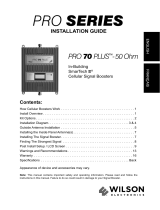 WilsonPro Pro 70 Plus (50Ω) Guide d'installation
WilsonPro Pro 70 Plus (50Ω) Guide d'installation
-
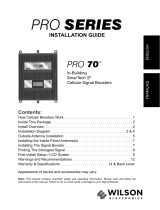 WilsonPro Pro 70 (75Ω) Guide d'installation
WilsonPro Pro 70 (75Ω) Guide d'installation
-
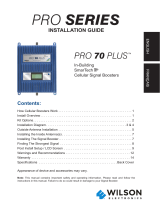 WilsonPro Pro 70 Plus (75Ω) Guide d'installation
WilsonPro Pro 70 Plus (75Ω) Guide d'installation
-
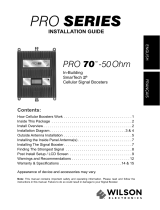 WilsonPro Pro 70 (50Ω) Guide d'installation
WilsonPro Pro 70 (50Ω) Guide d'installation
-
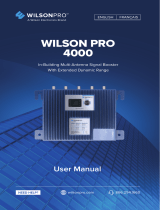 WilsonPro Pro 4000/4000R Guide d'installation
WilsonPro Pro 4000/4000R Guide d'installation
-
WilsonPro Pro Signal Meter: 460118 Guide d'installation
-
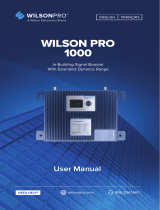 WilsonPro PRO 1000 Guide d'installation
WilsonPro PRO 1000 Guide d'installation
-
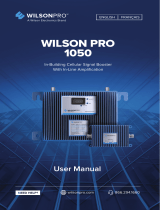 WilsonPro Pro 1050 Guide d'installation
WilsonPro Pro 1050 Guide d'installation
-
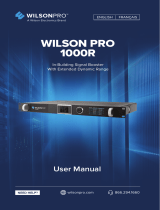 WilsonPro Pro 1000R Guide d'installation
WilsonPro Pro 1000R Guide d'installation
Autres documents
-
 Phonetone AN-L65AV Manuel utilisateur
Phonetone AN-L65AV Manuel utilisateur
-
Wilson Electronics 460119 Guide d'installation
-
weBoost Home MultiRoom Guide d'installation
-
Wilson Electronics 811201 Guide d'installation
-
weBoost U470008 Manuel utilisateur
-
weBoost Home Room U652020 Guide d'installation
-
Wilson Electronics Sleek Guide d'installation
-
weBoost 470354 Guide d'installation
-
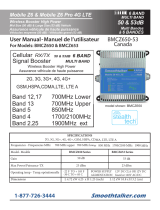 Smoothtalker Mobile Z6 50dB 4G/LTE High Power 6-Band Wireless Vehicle Cellular Signal Booster Kit Manuel utilisateur
Smoothtalker Mobile Z6 50dB 4G/LTE High Power 6-Band Wireless Vehicle Cellular Signal Booster Kit Manuel utilisateur
-
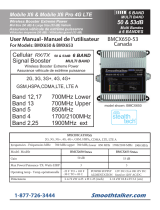 Smoothtalker Mobile Z6 50dB 4G/LTE High Power 6-Band Wireless Vehicle Cellular Signal Booster Kit Manuel utilisateur
Smoothtalker Mobile Z6 50dB 4G/LTE High Power 6-Band Wireless Vehicle Cellular Signal Booster Kit Manuel utilisateur


















































